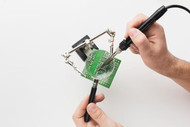Space Application Difficulties for Electronic Circuits
Posted by Staff - Soldertraining on May 13th 2023
Space application development is fueled by the quick (and thrilling!) advances in space technology. Electronic circuits are essential in all space applications to create effective and dependable space systems.
Correcting problems that go unattended in electrical circuits used in space applications costs a lot of money. The hostile atmosphere of space presents electronic circuits with several difficulties.
If you want to be part of this exciting field of space, then you can undergo IPC 620 training with Space Addendum. Practical cable construction activities accompany the course, and it is completed with a qualifying test. Then, Certified Instructors can teach Certified IPC Specialist (CIS) courses. To assure the efficiency of cable and wire harness assemblies which must withstand the vibration and temperature cycle conditions, getting to and functioning in space, IPC/WHMA-A-620 Space addendum specifies different standards over those stated in the IPC/WHMA-A-620.
The operating environment of electronic components has a significant impact on their dependability. The behavior of the materials changes as the temperature, pressure, and other environmental factors do, and the component may even fail in exceptionally difficult circumstances.
The following list of spatial conditions poses difficulties for electrical circuits:
Space Has No Pressure: Therefore, components made under atmospheric pressure may perform differently when exposed to these zero-pressure circumstances.
Ion And Particle Presence: UV radiation in space applications for low earth orbits damages molecules of helium, nitrogen, oxygen, and other gasses. These elements' atomic forms cause material corrosion and erosion. Space ions and free electrons can lead to arching, impacting delicate electronic components.
UV Deterioration: UV degradation affects the performance of components by altering the composition of materials and even removing oxygen from them.
Radiation: Single-event malfunctions in the free-particle radiation-emitted environment can make it difficult for sensors and controllers in electronic circuits to function properly.
High temperatures and thermal cycles put mechanical stress on electronic components, particularly integrated circuits (ICs) and their packaging.
The biggest cause of space electrical circuit failure, aside from the elements in space, is vibration during a space system's launch.
Problems Often Faced by Electronic Circuits in Space Applications
Damaged Circuit Boards
Vibrations can occur during the launching and separation stages for space applications. These processes can produce powerful shocks and vibrations to harm the circuit boards. Shocks and vibrations may short electrical components.
Circuit jerks can result in connector failures or loose connections. Data transfer or control loss caused by slack links or inconsistent connections can be fatal in space applications. Resonance in electronic components is a mechanical vibration-induced failure that poses a challenge for electronic space applications and should be solved to enable reliable missions.
Outgassing
Outgassing is one of the main issues with the applications of electrical circuits in space. The phenomenon of non-metallic substances releasing gasses is known as outgassing. Plastics, adhesives, PCB components, or thermal paste can help all offgas. Such materials can leak vapor or air that can accumulate on other parts and impair their functionality. Even short circuits amongst leads, connectors, courses, etc., might happen due to material vapor emission.
Life And Operating Functionality Are Reduced.
The large range of temperatures can dramatically reduce a component's operational functionality and shorten its lifetime. In orbit, the temperature can reach high levels, which has a negative impact on electronic circuitry. Failure can result from exposing commercially available components to either too high or too low temperatures.
Tin Whiskers
Tin, cadmium, zinc, and other electronic circuits and components develop whiskers in space's vacuum. These whiskers can cause short circuits because they are crystalline and electrically conducting.
Repairing a broken system is neither practicable nor economical, given the cost of space missions as a whole. When a mission is started, it's critical to address the difficulties experienced by electronic circuits in space applications.
Featured Image Source : https://img.freepik.com/free-photo/close-up-circuit-board-repair_23-2148419127.jpg?w=740&t=st=1680005019~exp=1680005619~hmac=a1a53e859d4fdcce87a2e9805d83ae37b368d6deab69fb78bc480718eb0c9695

